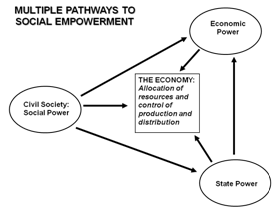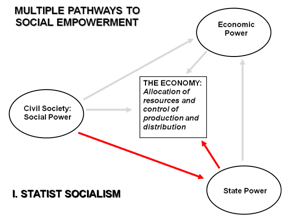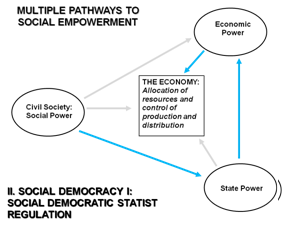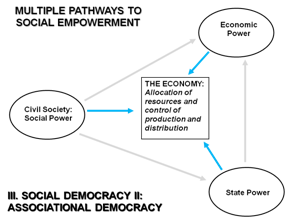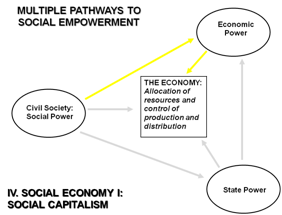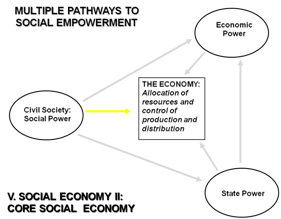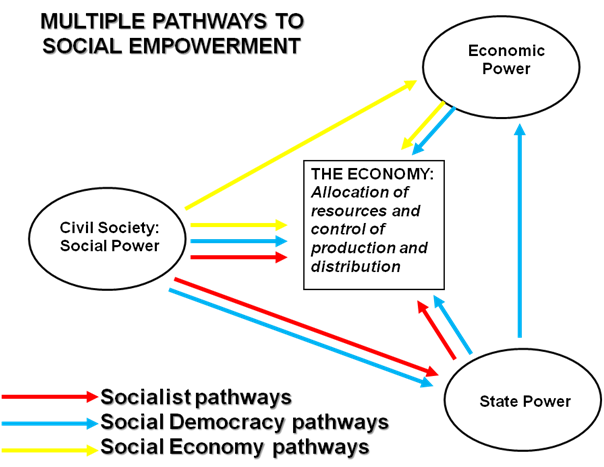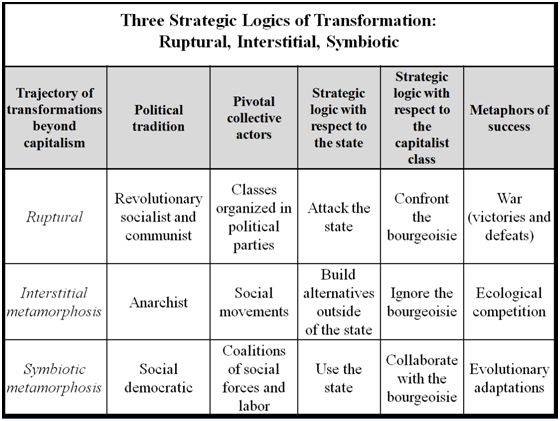This is a condensed version of Erik Olin Wright – Real Utopias – A Socialist toolbox
Some of this is directly lifted from Eriks articles. I have added some thoughts on how this might be applied to the Transition Movement as an example of it in practice.
Real Utopias Overview
Real Utopias are utopias that embody emancipatory ideals and they are real because they attempt to formulate viable institutional designs.
The emancipatory ideal:
An economy organized in such a way as to serve the needs and aspirations of ordinary people, not elites, and to do this the economy must in some way or another be controlled by ordinary people—that is, subordinated to social power. This is based on radical democratic egalitarian understanding of social and political justice based on the following three Moral Foundations: • Equality: In a socially just society all persons would have broadly equal access to the material and social means necessary to live a flourishing life. • Democracy: In a fully democratic society, all people would have broadly equal access to the necessary means to participate meaningfully in decisions about things which affect their lives. • Sustainability: Future generations should have access to the social and material means to live flourishing lives at least at the same level as the present generation.
Capitalism is the problem:
Wright view of Capitalism based on these 3 moral foundations finds that Capitalism is problematic: • Equality: Capitalism inherently generates levels of inequality in income and wealth that systematically violate social justice. • Democracy: Capitalism generates severe deficits in realizing democratic values by excluding crucial decisions from public deliberation, allowing private wealth to affect access to political power, and allowing workplace dictatorships. • Sustainability: Capitalism inherently threatens the quality of the environment for future generations because of imperatives for consumerism and endless growth.
Transforming the world:
There are two ways of trying to make the world a better place: 1. Ameliorative reforms: Look at existing institutions, identify their flaws and propose improvements. 2. Real utopias: Envision the contours of an alternative social world that embodies emancipatory ideals and then look for social innovations we can create in the world as it is that move us towards that destination.
There are 3 potential economic arrangements/powers: • Capitalism: an economic structure within which economic activity is controlled through the exercise of economic power based on the control of economic resources. • Statism: an economic structure within which economic activity is controlled through the exercise of state power based on the control of rule making and rule enforcing over territory. • Socialism: an economic structure within which economic activity is controlled through the exercise of “social power” based on capacity to mobilize voluntary cooperation and collective action.
The idea of HYBRIDS:
All real economic systems are complex combinations of these structures capitalism, statism, and socialism. We call an economy “capitalist” when capitalism is dominant. The possibility of socialism, therefore, revolves around the problem of enlarging and deepening the socialist component of the hybrid. Wright refers to this as the problem of pathways to social empowerment.
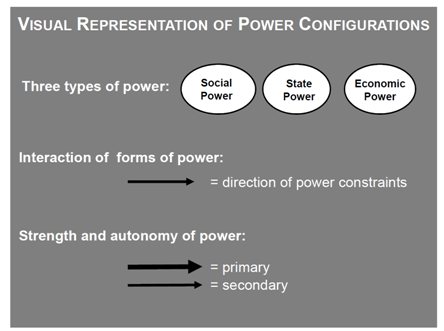
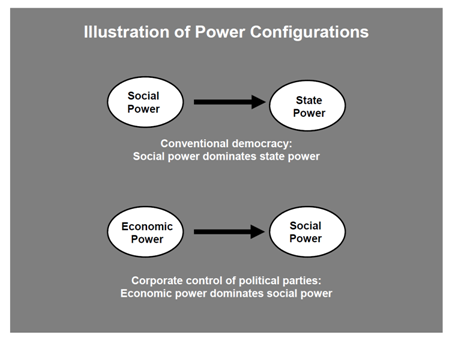
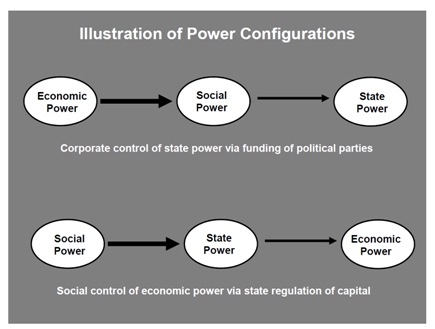
Two central problems of emancipatory social transformation that need to be addressed:
1. Institutional designs that reduce capitalist empowerment and increase social empowerment and civil societies control over economic power. 2. Strategies of transformation that can lead to this.
Below are the multiple ways in which social empowerment can be increased by: • social empowerment over the way state power affects economic activity • social empowerment over the way economic power shapes economic activity • social empowerment directly over economic activity
Statist socialism
• Political parties are associations formed in civil society with the goal of influencing states. • Their power depends upon their capacities to mobilize for collective actions of various sorts • Economic power is marginalised, civil society and the state organise the economy. • Classic Marxist idea of revolutionary socialism. • In theory Workers councils setup and represented within the state, if fully empowered them would institutionalise social power in the state. • Historically in Russia this resulted in centralisation of power in state and a top down domination. • This became Statism not social empowerment. • Nowadays Statism not seen as the way to social empowerment, but the state would still play a role in delivering public services. • Question is how this state provision can be managed by a democratically empowered civil society. • At present corporate power has a huge influence over state policies and public goods are often geared towards capital accumulation, not social needs.
Social Democratic Statist Regulation
• State constrains and regulates economic power. • Even with deregulation and triumph of free market ideologies state still regulates processes that impinges on economic power. • The extent to which these positive forms of state intervention are subordinated to social power becomes a pathway to social empowerment. • Often though state regulation is more responsive to the needs of capital than civil society. • Challenge is to what degree is it possible within capitalism to democratise state regulatory processes which undercut the power of capital and enhance social power.
Associational Democracy
• Civil society directly participates in governance activities usually along with State agencies. • Involves the joint effects of economic, social and state power coming together to manage economy. • To the extent that the associations involved are internally democratic and representative of interests in civil society, and the decision-making process in which they are engaged is open and deliberative, rather than heavily manipulated by elites and the state, then associative democracy can contribute to social empowerment.
Social Capitalism
• Economic power rooted in private ownership. • Civil society can through mechanisms directly affect the way economic power is used. • Example is Trade Union pension funds being used for public good. • Not limited to capital funds controlled by civil associations in society, could also include collective involvement of workers in aspects of workplace management. • Replacing shareholder councils with stakeholder councils on corporate board of directors. • Workers councils within the workplace. • Consumer orientated social movements that put pressure on corporations, protests, boycotts etc.
Core Social Economy
Direct involvement of secondary associations in civil society organising various aspects of economic activity, not simply shaping economic power. This is a alternative way of directly organising economic activity that is distinct from capitalist market production, state-organized production or household production. Production organised by collectives directly to satisfy human needs, not subject to profit maximisation or state technocratic rationality. Examples would be community organised healthcare, NGOs that facilitate fair trade cutting out the middle men, community land trusts that remove land from the market. In capitalist societies this is currently funded by charitable donations, a lot are organised by religious institutions. Alternative could be for The State to fund this type of work from taxation as happens in Canada with their healthcare system. Obstacles to expansion of this social economy are providing an adequate standard of living for people working within it, an unconditional basic income could overcome this.
Problems of social power:
These five pathways show ways in which social power potentially take control over economic production and distribution, which means we are moving closer to socialism. Good reason to be sceptical of how power in civil society could be organised to take on control of allocation of resources for production and distribution.
Two big problems:
Firstly, Civil society is not a consistent coherent whole it is a multitude of different organisations with different ideas, goals and solidarities, that includes opposing views. Many organisations in Civil society are based on self interest and exclusion and preservation of privilege, why would these groups lead to ameliorating the harms of capitalism, let alone to human emancipation?
This vision of socialism requires a state and thus differs from anarchism, on the basis that: A state is needed to create the rules of the game and mechanisms of coordination that allow civil society to to achieve the necessary integration to control either state or economy.
Secondly, civil society groups contain many associations that are inconsistent with egalitarian emancipatory ideals, which could lead to tyranny of the majority. The challenge would be how to devise an institutional framework for democratic deepening and associational empowerment which would foster radical, democratic, egalitarian conceptions of emancipation. The more we move olng the pathway of social empowerment the more favourable the conditions would be for this.
Strategic logics of Transformation:
The five proposals above do not propose to be a blueprint for a socialist society as you would need many other institutional transformations. That said if these were implemented in a serious thoroughgoing way, capitalism would be profoundly transformed. Taken singly they may seem modest reforms, but taken together they would challenge the class relations and the structures of power. Capitalism would be a much subordinated power.
These utopian designs are not achievable under the current existing social and political conditions. Achievability depends on the powers of social actors and the context in which they act, you need to understand the strategic logics of transformation.
There are 3 general collective strategies that can help us move towards social emancipation:
1. Ruptural (radical break in institutions): Revolutionary socialist tradition. Ruptural strategies directed at capitalism as a system are implausible, but ruptures in specific institutions may be needed to open up possibilities for symbiotic transformations. The idea is a sharp discontinuity and rapid change rather than a metamorphosis over time. 2. Interstitial (build new institutions in the cracks of the system): Anarchist tradition. Interstitial strategies create building blocks of emancipatory alternatives. These often don’t pose an immediate threat to Capitalism and are often ignored by more radical critics of capitalism as being merely symbolic, but cumulatively they can pose a serious challenge and also make a difference to peoples lives. 3. Symbiotic (use existing institutions to solve problems in ways that transform institutions): Social democratic tradition. Symbiotic strategies are needed to expand the space for interstitial transformations. These often have a contradictory element to them in that they can help stabilise capitalism in the short term but provide shifts in power over the long term.
In practice the hope is that there is a hybrid of developments that encompass all of these tactics. They all contain ricks and dilemmas and none of them is probably sufficient on its own. Often activists become deeply committed to one model seeing it as the way forward and they utilise lots of energy fighting against rejected models.
A long-term project with any prospects for success must grapple with the messy problem of combining these strategies, even if the combination inevitably means that struggles often operate at cross-purposes
How this relates to Transition Movement:
Transition can be seen as the manifestation of social power through civil society, where it acts to get people in communities together to build solidarity and address problems. It is not really involved in Ruptural transformation, although it could be supportive of this type of transformation, if it occurs particularly at Institutional level and as supportive in terms of providing practical support after a rupture had taken place.
Overall though, it tends to be much more involved in Interstitial metamorphosis and Symbiotic metamorphosis depending on the people involved in the Transition Initiative. Examples of Interstitial metamorphosis within Transition are things like food projects, reskilling, energy coops, community supported agriculture etc. These projects are removing areas of production from the capitalist system, though they will still be interacting with it, but crucially they are often run on cooperative principles utilising different models of participation. REconomy can be seen as example of Symbiotic metamorphosis, that is a process of reorganising local economies to benefit local communities, which also provides mutual benefits to Local Authorities in terms of providing jobs, or services that also help sustain Capitalist model, even though it is also changing the social relations in some aspects.
So Transition can be a vehicle for Social Change, predominantly through increasing social power and the scope of civil society. It can be used to help affect change in all of the pathways that Wright highlights as increasing social empowerment. In practice Transition is predominantly acting in the social economy pathways highlighted, though it can be present in Socialist and Social Democracy pathways, depending on the people invovled in the Transition Initiative. Transition also suffers from the problems that Wright highlights as problematic for civil society. Not everyone invovled in Transition would see themselves as anti-capitalist, in fact they may be supportive of Capitalism, that is not to say that there are many whom are critical of Capitalism. There is also not explicit aims of social justice outlined like Wright does in terms of equality, democracy and sustainability within Transition Initiatives as people are attracted to Transition for a variety of reasons that may or may not align with some of these values.
Films
Content goes here
More information

